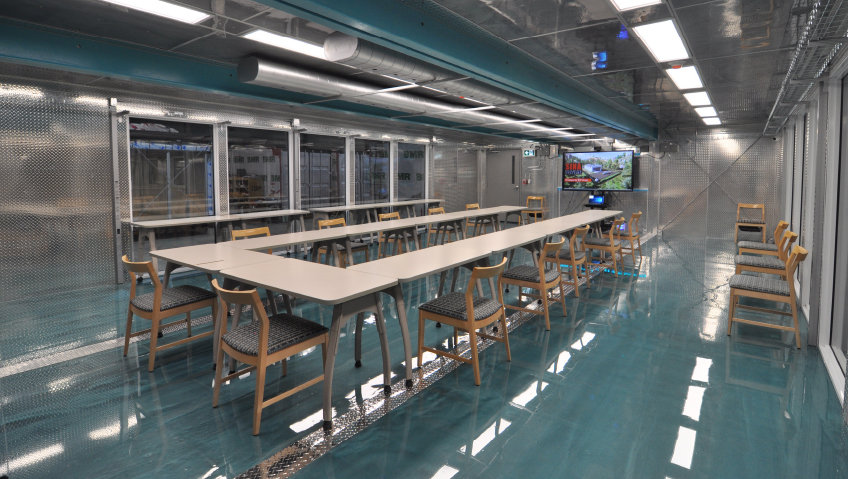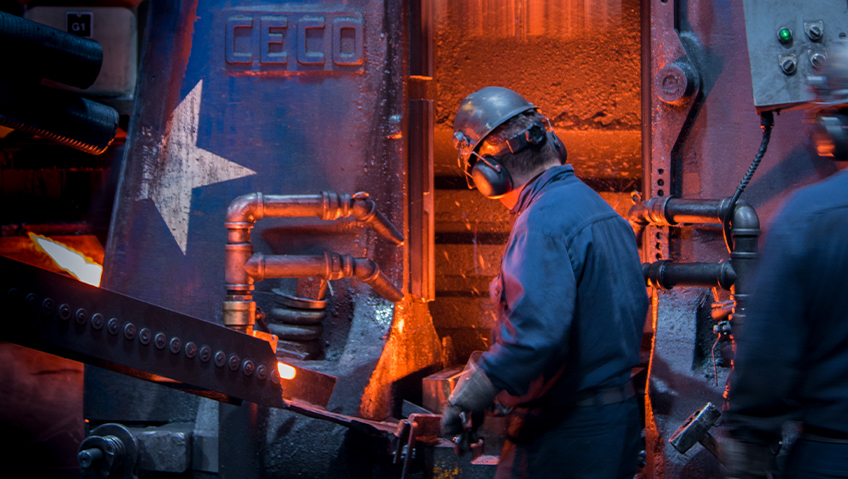The IDP Group has done a major pivot, with a new focus on steel-based pre-fabricated construction solutions that might help address housing needs in rural or isolated locales. The company has also embraced an innovative manufacturing methodology that aims to “turn construction into Advanced Manufacturing,” as Operations Manager and Partner Hamed Asl puts it.
Founded in 2001, the IDP Group consists of a collection of companies based in Chesterville, Ontario. While the firm continues to offer warehousing, logistics, furniture configuration, and asset management services, prefabricated construction is now central to the company’s mission.
“There is a long list of services that we provide, but our focus for the past while has been to grow the steel, prefabricated building business. That is currently the main source of revenue,” explains Asl.
The company operates from a sixty-five-acre property featuring twenty buildings with warehousing and storage space and a shipping bay. Some facilities at the property are now primarily devoted to steel, prefabricated construction work, aimed at a very specific clientele.
“Right now, our primary focus is government and remote and Indigenous communities. You could use our multi-storey product line in Toronto, but that is not where the need is the greatest, and we are focusing on where people need infrastructure solutions the most,” he says.
The company is putting the final touches on its first steel, prefabricated project—a 6,000-square-foot laboratory and classroom space for the Royal Canadian Navy (RCN). This facility features full reinforced steel core, negative and positive pressure HVAC systems complete with HEPA filtration throughout the entire building, a complex system of solar and wind energy as well as backup generators, pre-built reusable concrete foundation with adjustment capabilities, and epoxy-treated concrete ceilings and floors to enhance resiliency. The facility will be used by the navy for training purposes.
Another exciting potential project involves a steel fire monitoring station for use in Northern Ontario. If brush is cleared around the facility, the steel structure should be able to provide up to two hours of fire resistance while the exterior fire suppression system with remote triggered pumps can soak the outside of the building and surroundings to help minimize damage while the fire passes, states Asl. In a flash-fire of short duration, occupants of the station would remain completely safe with the internal fire safety chamber and clean agent fire suppression system.
In addition to these assignments, he speaks excitedly about the possibility of helping Indigenous communities. Residential buildings on First Nations in Canada are often poorly constructed and are unsafe or unhealthy to live in. Replacing these structures would require a mammoth effort involving thousands of new residences. Asl says IDP Group’s prefabricated buildings could be part of any solution to address the Indigenous housing crisis. In addition to residences, the company could construct steel, prefabricated healthcare facilities for Indigenous communities, and is currently working with Indigenous communities to build small healthcare/hospital units, he adds.
Regardless of the end-user, IDP Group does not offer standardized products but takes a custom design approach. “We don’t have a certain product on the shelf that you buy. You come to us and say, ‘This is our problem.’ We spend some time with the customer, without any cost to them, then we start designing a solution to meet their need,” Asl explains. “Our slogan is ‘Re-think the box,’ re-think what has been possible until now.”
While there are several other companies in the prefabricated construction space, IDP Group stands out for numerous reasons. For one thing, the company aims to construct steel, prefabricated buildings that can be assembled on-site with minimum hassle. It does this by making a handful of big, easy-to-put-together structural elements rather than a vast number of tiny components that need to be assembled on-site in a time-consuming process. To give an example of the scale involved, some structures it handles are up to forty feet long.
“The main difference with our building systems is the readiness when it arrives on-site. We can erect a 1,000-square-foot fully-functioning building in two days,” states Asl. “Everything is finished when it ships. It’s like connecting Lego pieces together; add two more days and we can use our seismic-rated, pre-built concrete foundation system and you go from grass field to a 1000 square foot building in a week or less.”
This easy-to-assemble principle does not just apply to the exterior of the structure but also includes the electrical, mechanical, and heating systems.
“If a building module that is forty feet long parks beside another building module that is forty feet long, you can connect these two modules on the electrical work in sixty seconds. There’s no way to make a mistake, based on how they’re designed to fit each other. There’s no other way to fit them together—this one module will only marry with the other one,” he says.
IDP Group had to do a bit of a manufacturing rethink prior to its move to steel-based prefabrication construction work. The firm wanted to manufacture the steel structural elements of its prefabricated buildings in-house using production-line techniques. The company examined methods used in vehicle manufacturing to see if there were any processes it could adopt. Robotics and automation are central to vehicle production, so it decided to follow suit.
“When it comes to handling steel—cutting it, building it, moving it, painting it, prepping it, assembling parts, automation and robotics has done a fantastic job in the car industry for the last twenty years,” notes Asl.
IDP Group acquired equipment from ABB Robotics, a renowned robot manufacturer. There was a technical learning curve, as the company implemented robotic solutions into its prefabricated workflows. Things were eventually sorted out and the company currently uses an ABB robotic system for plasma cutting and plans to introduce more automation and robotics.
If all goes to plan, within “two or three years from now, we will have a production line that produces infrastructure and not just components that you have to assemble later on,” Asl says.
The company also decided it would master any new prefabrication construction services and applications so such work could be performed in-house. Having such capabilities gives the group confidence and flexibility. While it can take on any prefabrication production tasks, the company subcontracts out electrical work and other duties to speed up the construction process. “At the speed we are innovating and growing, we need to have in-house capability to do almost everything, especially when going down the path of ‘never done before.’ Every day is R&D; while building new components for our buildings, we also need to consider how to build the ‘production line’ that will use some sort of automation to produce that part, hence we need to continuously have a very strong in-house capability.”
IDP Group offers buildings that can be easily moved or firmly connected to the ground. To this end, it developed a prefabricated concrete foundation system that enables its buildings to be firmly anchored in place, and this system can be shipped to isolated regions.
“If you are going to a remote community, there’s no concrete plant. We’re not a prefabrication building company that says, ‘Well, you need a foundation, then we’ll erect [the building].” You give us a grass field; we give you a building,” states Asl with pride.
Similarly, the company can design prefabricated structures with rooftop solar panels and a wind turbine. While the structure would also have a generator for backup energy the basic idea is to create buildings that can fully function off the power grid. “We ship it with its own energy [supply] so it’s essentially self-sufficient.”
All prefabricated construction work is done to national building codes and vetted by third-party inspectors he adds. So far, IDP Group has built 8,000 square feet of steel, prefabricated structures.
The firm has not abandoned its older service offerings, however, as evidenced by its response to the outbreak of COVID last year. When COVID hit, IDP Group laid off roughly fifteen to twenty employees and “started doing a lot of warehousing and storage—which are not very labour heavy,” he recounts.
Laid-off workers have been since hired back, along with new staff. The firm currently has forty-five employees, a figure that can expand to fifty-five if part-timers are included in the mix.
The company “will still carry on with all the other businesses. This is a new thing we’re doing. We want to keep our other sources of revenue,” states Asl.
Indeed, IDP Group has a reputation for providing excellent warehousing and storage services, complete with a customized, software-based warehouse management system to track inventory. The warehouse also has Wi-Fi connections to smart devices, computers, and monitors.
Customers of IDP Group’s warehousing and storage services and interior retrofit work, past and present, include Bank of Canada, Royal Canadian Mint, TD Canada Trust, the House of Commons, Queen’s University, Health Canada, the RCMP, and other federal government departments and companies. It also provides customized logistics and delivery, third-party distribution support, cross-docking, and material handling.
As it continues to expand its prefabrication work, the company faces huge challenges in the form of supply chain woes and a shortage of skilled labour.
“Supply chain is a huge problem across the board, which is a bit surprising. The supply chain was better at the height of COVID than today. Prices keep going up. We’re taking advantage of our warehousing [space] and trying to buy product in bulk that allows us to go ahead with production,” states Asl.
There has been a profound shortage of skilled labour across North America for the past few years, as older workers in the sector hit retirement age and not enough younger people are replacing them. Making matters slightly more complicated for IDP Group is the company’s unique manufacturing approach, which centers on turning construction into production.
For all that, Asl is extremely excited about IDP Group’s transition into steel-based prefabricated buildings. “We want to expand—not just hire more people. We also want to push toward automation,” he states. “We are looking to expand our production ten-fold in five years and build automated production lines that build buildings. That’s our focus, that’s our mission.”






